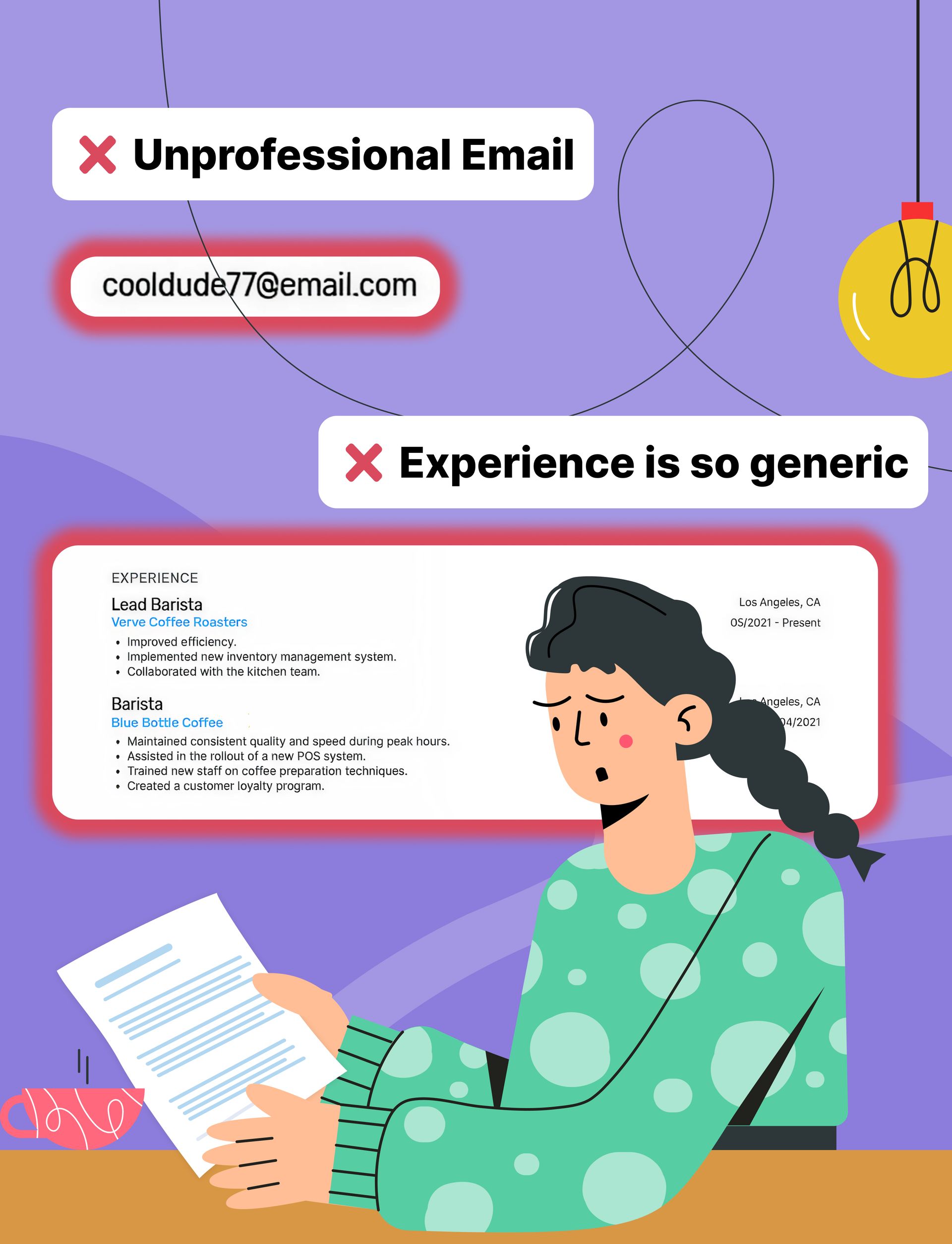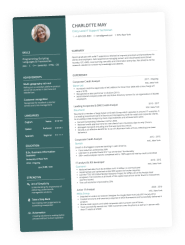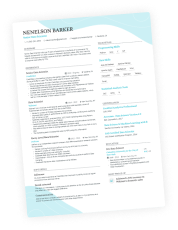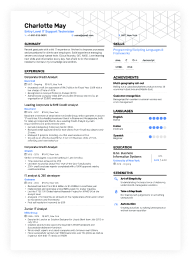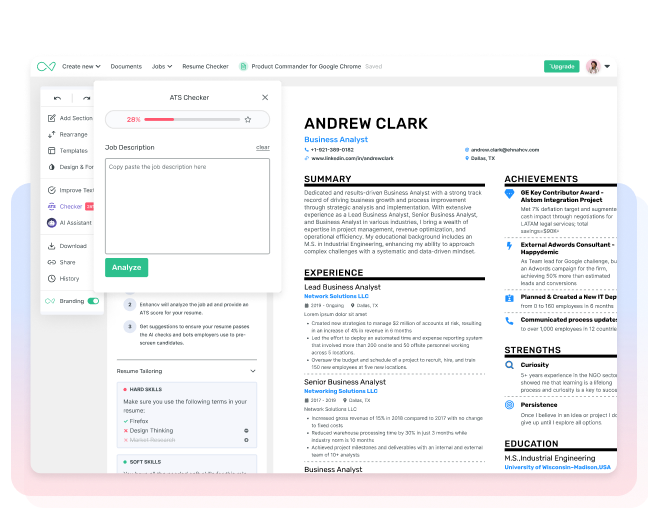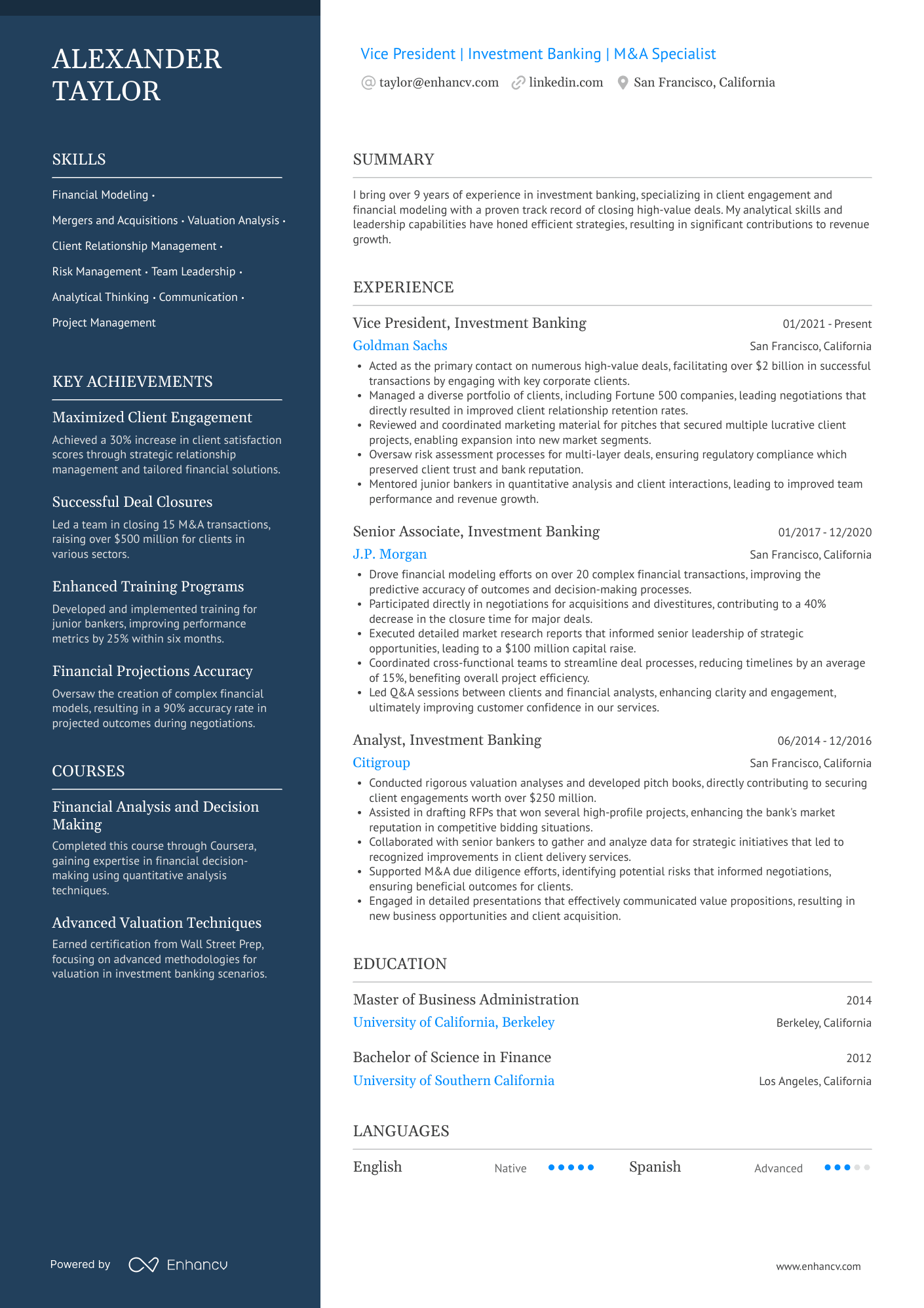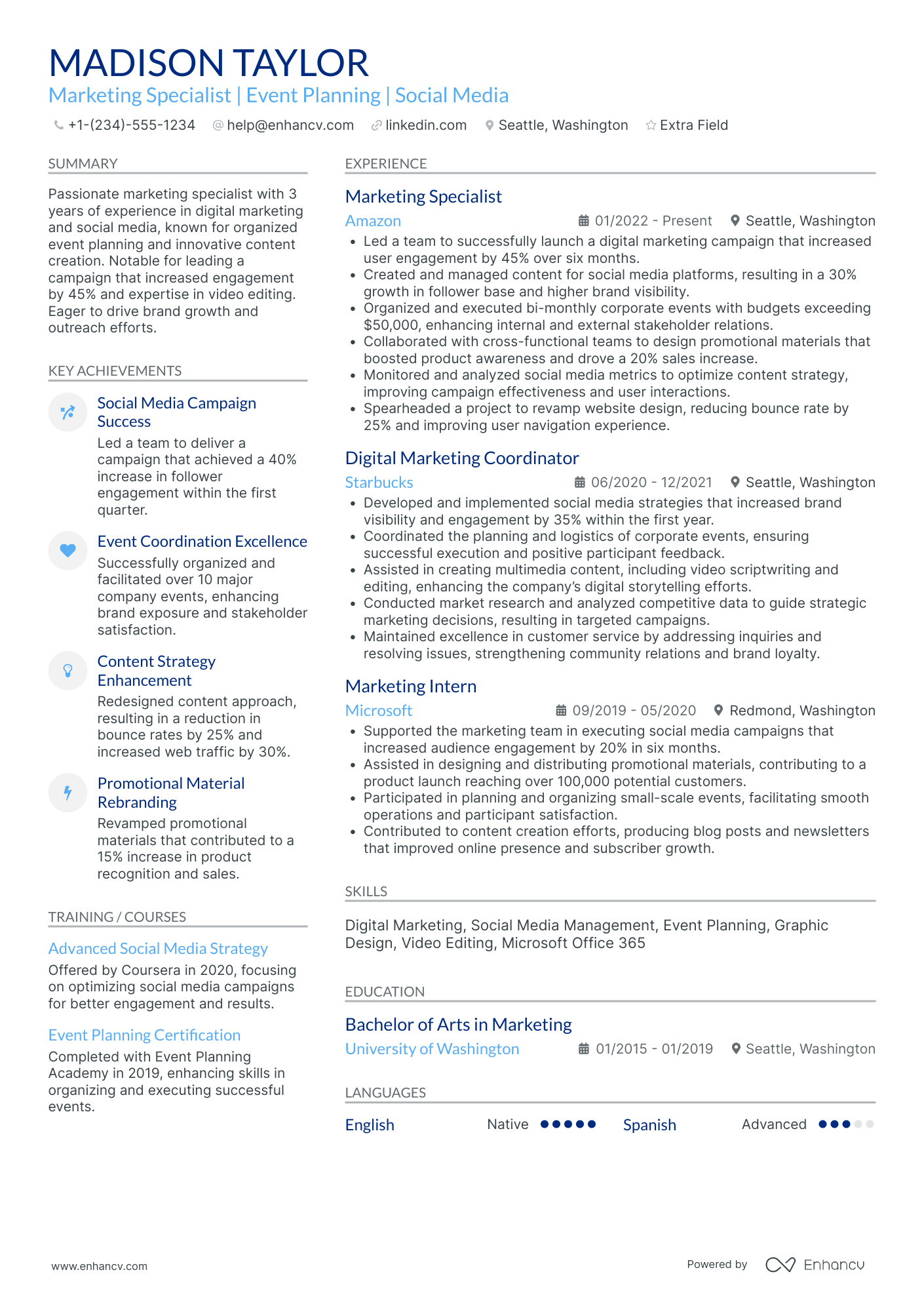Misinformation about resumes spreads quickly, and some of the most repeated “rules” online do more harm than good. Small details—the kind that are easy to overlook—can quietly undermine your application before it reaches a hiring manager’s eyes. These aren’t just obvious typos or formatting errors, but subtle missteps rooted in outdated advice.
Drawing on our work as Certified Professional Résumé Writers (CPRWs), we’ve identified the 20 most common mistakes that hold candidates back. More importantly, we’ll show you exactly how to correct them. Each tip is practical, clear, and focused on helping your resume pass every stage—from applicant tracking systems to the recruiter’s desk—without losing momentum.
Key takeaways
- A generic, one-size-fits-all resume is the #1 mistake. Tailor each application to the role and company.
- Formatting that works with applicant tracking systems (ATS) is non-negotiable if you want your resume to be searchable and scannable.
- Replace vague buzzwords with measurable achievements to prove your value.
- Keep your resume updated regularly to capture recent wins and skills.
- AI can speed up resume writing, but your input ensures accuracy, authenticity, and relevance.
Before you start making changes, it helps to get a clear picture of where your resume stands. Еnhancv’s free Resume Checker can highlight strengths, flag weak spots, and give you a baseline for improvement.
Is your resume good enough?
Drop your resume here or choose a file. PDF & DOCX only. Max 2MB file size.
Now, let’s look at the most common resume mistakes and how to avoid them.
1. Sending the same resume for every job
A resume isn’t just a record of your work. It’s your first introduction to decision makers in a given organization. Sending the exact same document to every employer can make you look disengaged, as though you’re applying on autopilot.
A generic application often skips over the keywords recruiters are scanning for, ignores the priorities laid out in the job description, and misses the chance to connect your experience to the company’s needs.
In a competitive market, blending in is the fastest way to be overlooked. That’s why tailoring your resume matters—it shows you’ve paid attention, you understand the role, and you’re ready to deliver on it.
How to avoid this mistake
- Keep a “master resume” with all your roles, skills, and achievements.
- Before applying, edit it to match the job posting.
- Weave in the same terminology and priorities used in the listing so your fit is clear to both ATS software and the human reviewer.
The fastest and most reliable way to tailor your resume is with an AI resume builder like Enhancv.
Our Resume Tailoring feature uses AI to customize each application so it aligns with the job requirements. You’ll instantly get specific, actionable tips for rewriting or adding content, saving you time while making your resume a stronger match for every position you apply for.
2. Ignoring ATS-friendly formatting
We already mentioned applicant tracking systems in the previous section—and for good reason. If recruiters are your number one audience, ATS software is a close second. It’s the tool many employers use to organize, store, and search through applications, especially when there are hundreds to review.
An ATS scans your resume for keywords, standard section headings, and formatting it can process easily. If your document relies on complex graphics, unusual layouts, or omits relevant terms, it may not appear in a recruiter’s search results, even if you’re highly qualified.
How to avoid this mistake
- Use standard section headings: Stick with common labels like “Work Experience,” “Education,” “Skills,” and “Certifications.” These make it easier for ATS—and recruiters—to find the right information quickly.
- Keep the layout simple: Use a simple format with clear spacing. Avoid text boxes, columns, tables, and images, which some ATS systems can’t read.
- Choose readable fonts: Fonts like Arial, Rubik, Lato, or Vokhov are both professional and ATS-compatible.
- Avoid unusual file types: Unless stated otherwise, send your resume as a PDF. Both PDF and Word files are generally supported by ATS software, but Word documents can sometimes shift formatting depending on the system or device.
- Integrate keywords naturally: Review the job description, identify repeated phrases and essential skills, and work them into your experience and skills sections. Don’t “stuff” them in—aim for a natural flow.
- Test before sending: Use a tool like Enhancv’s free Resume Scanner to see how your resume is parsed and whether important details show up correctly.
Here’s an example of a strong ATS-friendly resume you can open in our app, edit to fit your experience, and personalize for any role:
3. Outdated or incorrect contact information
It sounds obvious, but you’d be surprised how often this slips through. A missing digit in your phone number, a typo in your email address, or an outdated LinkedIn profile can mean recruiters simply can’t reach you. Even small changes in your contact details—like switching to a new phone or email—can create a silent dead end for opportunities.
Your contact information is the bridge between you and the hiring team. If it’s broken, the rest of your resume, no matter how strong, won’t get you anywhere.
How to avoid this mistake
- Always double-check your phone number, email address, and any links before sending your resume.
- Use a professional email address that includes your name.
- Update your LinkedIn profile URL and make sure it’s correct on your resume.
- Save your resume with a clear, professional file name (e.g., Firstname_Lastname_Resume.pdf).
- Each time you start a new job search, review the info on your resume header first before updating other sections.
4. Adding a photo (when not required)
In some parts of the world, adding a headshot is standard practice. In others—including the United States—it’s not only unnecessary but can work against you.
Most recruiters don’t expect to see a photo, and many employers prefer not to receive them to avoid potential bias concerns during the hiring process. Unless the job posting specifically requests it (which is rare), a headshot adds little value for the roles most applicants are pursuing.
Your resume’s job is to open doors based on your qualifications, not your appearance.
How to avoid this mistake
- Skip the photo unless it’s explicitly required for the position (models, actors, and broadcasters are an exception).
- Focus on strengthening your LinkedIn page—chances are recruiters will check it and see your professional portrait anyway.
- If you want more visual appeal, use clean design elements and subtle color accents instead of images.
- For creative industries where visuals matter, consider including a portfolio link rather than embedding a photo.
5. Choosing hard-to-read fonts
The font you choose shapes the first impression of your resume. Decorative or overly stylized typefaces can make your document difficult to read, especially on smaller screens, and may confuse ATS processing the text. Even if your content is strong, poor readability can turn a recruiter’s quick scan into a hard pass.
Your goal is to make every word as clear and accessible as possible, both for humans and for software.
How to avoid this mistake
- Stick to clean, professional fonts like Arial, Rubik, Lato, or Volkhov.
- Keep font sizes consistent (10–12 pt for body text, 14–16 pt for headings).
- Avoid special characters or decorative scripts for key information.
- Test your resume on different devices to ensure it’s legible everywhere.
6. Overcomplicated or distracting design
Just like the wrong font can make your resume hard to read, an over-the-top layout can overwhelm the reader and confuse ATS software. Bright colors, heavy graphics, or decorative borders might seem eye-catching, but they often distract from the substance of your application.
Recruiters spend seconds scanning for key details. If your design makes it hard to find your experience, skills, or education, they may not dig deeper. And in some cases, ATS systems can’t interpret complex layouts, meaning your information might not be stored or displayed correctly.
A strong resume design should guide the reader’s eye, not compete for attention.
How to avoid this mistake
- Stick to a modern layout with clear headings and sections.
- Use lines or white space strategically to separate different parts of your resume.
- Limit the use of color—one accent color is enough.
- Avoid graphics or text boxes for essential information. If you want to add small visual touches, Enhancv’s icons and logo options are designed to be ATS-friendly while keeping your document clean.
- Test your resume in plain text form to see if all content is still accessible.
Ready to give your resume a clean, professional look?
Explore Enhancv’s library of expertly designed resume templates—all ATS-parseable, easy to customize, and built to make your experience stand out.
Strong design isn’t just about avoiding clutter—it’s also about consistency. Even a simple, single-column resume can feel disorganized if the formatting is all over the place.
7. Weak or inconsistent formatting
One of the most common formatting mistakes we see comes from resumes built in Microsoft Word or Google Docs. These tools are great for general documents, but without precise formatting controls, it’s easy to end up with uneven spacing, misaligned sections, or mismatched bullet styles. What looks fine on your screen can shift entirely when opened on another device or operating system.
Inconsistent formatting makes your resume harder to skim and can give the impression you lack attention to detail, even if your experience says otherwise.
How to avoid this mistake
- Use the same font style and size for similar elements (e.g., all job titles, all dates).
- Keep line spacing and margins consistent (between 0.5 and 1 inch) throughout.
- Align dates, locations, and section headings neatly for easy scanning.
- Save and test your resume in PDF format to avoid layout shifts.
A resume builder like Enhancv keeps every section perfectly aligned, applies consistent styling automatically, and ensures your document looks exactly the same on every screen. That means you can focus on your content instead of wrestling with formatting quirks.
8. Using vague, overused language
Terms like “hard-working,” “team player,” or “go-getter” might sound positive, but to recruiters, they’re clichés. They tell the reader nothing concrete about what you’ve actually achieved. When every applicant describes themselves with the same buzzwords, those phrases lose meaning, and your resume blends into the pile.
Recruiters and hiring managers want proof, not self-praise. Without specific examples, buzzwords can feel like filler, suggesting you’re either exaggerating or unsure how to describe your real strengths.
How to avoid this mistake
How to avoid this mistake
- Replace vague adjectives with measurable, action-driven statements.
- Use strong verbs that show what you did: “led,” “designed,” “implemented,” “increased.”
- Pair actions with results: “Implemented a new onboarding process that reduced training time by 20%.”
- Let your achievements demonstrate your skills, instead of simply naming them.
9. Typos, grammar, and formatting errors
A misspelled word, a misplaced comma, or inconsistent capitalization can suggest you lack attention to detail—a red flag for many roles.
In a competitive hiring process, recruiters look for reasons to narrow the pool quickly. Mistakes like these, even if unintentional, can make them question your professionalism and care in other areas of work.
How to avoid this mistake
- Proofread your resume slowly, line by line.
- Use built-in spelling and grammar check tools, but don’t rely on them entirely—they don’t always read meaning.
- Read your resume aloud to catch awkward phrasing or missed words.
- Have a trusted friend, colleague, or mentor review it—fresh eyes catch details you might miss. (Use Enhancv’s Share button to send it instantly and make the process easier.)
10. Listing every job you’ve ever had
We’ve already talked about tailoring your resume to the role—and part of that means being selective about what you include. A resume isn’t meant to be an exhaustive career history. When you list every single job, especially ones unrelated to the role you’re applying for, the relevant details get buried.
Hiring managers don’t need to know about a summer job from 15 years ago if it has no connection to your current career path. Too much unrelated information can make your resume look unfocused and force the reader to dig for the good stuff—and many won’t take the time.
How to avoid this mistake
- Keep your work history to the last 10–15 years, unless an older role is directly relevant.
- Remove jobs that don’t relate to the position, unless they fill an employment gap you want to explain.
- Focus on roles where you gained skills and experience that match the job description.
- If you’re early in your career, highlight transferable skills from unrelated jobs but keep descriptions brief.
11. Resume too long or too short
Listing every job you’ve ever had isn’t the only way length can work against you. A resume that’s too long can overwhelm recruiters, while one that’s too short can make you seem inexperienced.
The goal is to give just enough detail to show you’re a strong fit, without making the reader sift through extra pages or guess at your capabilities.
Length becomes an issue when it’s a symptom of poor editing or a lack of relevant content.
How to avoid this mistake
- Aim for one page if you have under 10 years of experience.
- Go up to two pages if you have a longer career or extensive relevant achievements.
- Edit ruthlessly—cut details that don’t directly support the role you’re targeting.
- If your resume feels too short, add more quantifiable achievements, skills, or relevant projects.
Resume length statistics
According to Enhancv’s latest survey, recruiters are 70% more likely to prefer two-page resumes when the candidate’s experience warrants it. On average, those with two-page resumes had around 15 years of professional experience.
12. Exaggerating or lying about experience
It might be tempting to “polish” your work history or stretch the truth about your skills, especially if you think it’ll help you get noticed. But any false detail, from inflating your job title to claiming a certification you never earned, can backfire quickly.
Why? Recruiters and hiring managers often verify details through reference checks, LinkedIn profiles, or even a quick phone call to a past employer. If they discover a discrepancy, it’s not just that one job you’ll lose—your credibility takes a hit, and it can close doors for future opportunities.
How to avoid this mistake
- Be truthful about your abilities, experience, and achievements.
- If you’re missing a qualification, focus on transferable skills and your ability to learn quickly.
- Use honest but confident wording—you don’t have to undersell yourself to be accurate.
- Highlight projects, volunteer work, or training that show your potential without misrepresentation.
13. Listing responsibilities instead of achievements
One of the most common resume mistakes is treating your work history like a list of job descriptions.
Responsibilities outline what you were supposed to do. Achievements show what you actually did.
When your resume only lists duties—“Managed a team,” “Handled client accounts”—it reads like a copy-paste from your old job posting and adds little weight to your candidacy.
Why is this such a critical misstep? Recruiters compare candidates who often have similar roles in their past. Accomplishments help you stand out by showing measurable results: revenue you increased, processes you improved, goals you exceeded. Without them, your application blends in with everyone else who has the same title.
How to avoid this mistake
- For each role in your experience section, list three to five measurable achievements.
- Use the STAR method (Situation, Task, Action, Result) to describe successes in a way that’s clear and compelling.
- Start each entry with a strong action verb (led, created, improved, increased).
- Add metrics where possible—percentages, dollar amounts, time saved.
- Consider creating a dedicated “Key Achievements” section to highlight standout results in one place.
- Focus on impact: what changed because you were in the role?
14. Including references on the resume
Another surprisingly common resume mistake is adding a references section—or even listing people’s names and contact details directly on your resume. It takes up valuable space that could be used to highlight your qualifications.
In most hiring processes, references aren’t requested until later, often after an interview. Recruiters know they can ask for them when they need them, so your limited page space is better spent proving why you’re the right candidate.
How to avoid this mistake
- Leave the references section off entirely.
- Keep a separate, up-to-date reference list ready to share when requested.
- If a job posting specifically asks for references, submit them as a separate document.
- If absolutely necessary, you can note “References available upon request” within the context of an experience entry (for example, under a role where you worked with a referee). Alternatively, you can include this mention in your cover letter.
15. Including irrelevant personal details
One resume mistake we often see, especially from international applicants, is adding personal details that aren’t standard in the country they’re applying to. In some countries, resumes (or CVs) commonly include information like age, marital status, religion, or nationality.
In the United States, Canada, and several other regions, this information is not only unnecessary but can raise bias concerns.
Recruiters in these markets focus solely on your skills, qualifications, and relevant experience. Adding personal details that don’t relate to the role wastes space and risks drawing attention away from your professional strengths.
How to avoid this mistake
- Research resume norms in the country where you’re applying.
- Limit contact information to your name, phone number, email, and LinkedIn URL.
- Leave out sensitive or unrelated personal details like age, gender, marital status, or religion.
- If you’re unsure, review local job postings or use a template designed for that market (Enhancv templates can be tailored to regional standards).
16. Stating salary expectations
Another resume mistake that can hurt your chances is including salary expectations before the employer has asked for them. While it’s important to know your worth, putting a number on your resume can send the wrong signal—that you’re more focused on pay than on the role itself.
Salary discussions are best saved for later in the hiring process, usually after you’ve had the chance to present your value and understand the full scope of the job. Plus, it’s more common—and more appropriate—to address salary expectations in a cover letter, if at all, rather than on your resume.
How to avoid this mistake
- Keep salary expectations off your resume unless the job posting specifically requests them.
- Use the early stages of the hiring process to learn more about the role and responsibilities.
- If asked for your expectations early, you can give a range based on market research rather than a fixed number.
- To avoid turning off employers prematurely, focus your resume on skills and results—the things that make you worth the salary you’ll negotiate later.
17. Listing irrelevant skills
A common resume mistake is including skills that don’t match the job you’re applying for. Filling your skills section with every tool, platform, or ability you’ve ever touched can make it harder for recruiters to see your most relevant qualifications. It also risks diluting your expertise by placing high-value skills alongside ones that are outdated, basic, or unrelated.
Another faux pas is listing soft skills—like communication, teamwork, or leadership—on their own without context. While these traits matter, simply naming them doesn’t prove you have them. Recruiters want to see these qualities demonstrated through your work history or achievements.
How to avoid this mistake
- Start with the job description: identify the must-have skills and list only those you genuinely possess.
- Group technical and industry-specific skills in your dedicated “Skills” section.
- Weave soft skills into your achievements, summary, or bullet points to show them in action.
- Remove outdated tools, irrelevant certifications, and basic proficiencies most candidates are expected to have (e.g., “Microsoft Word”).
- Keep your skills section focused and concise so it highlights your strongest, most relevant abilities.
18. Using a generic or weak summary statement
The top section of your resume is the first thing recruiters read. One of the most costly resume mistakes is wasting that space on a bland, copy-paste summary like “Motivated professional seeking a challenging position.” These vague phrases could apply to almost anyone and do nothing to set you apart.
If your resume summary fails to communicate your unique value, the recruiter won’t have a reason to keep reading. That opening needs to quickly connect your strengths to the employer’s needs.
How to avoid this mistake
- Write your summary after you’ve tailored the rest of your resume, so it reflects the most relevant competencies and successes.
- Use three to four concise sentences that underscore your unique experience and role-specific expertise.
- Reference the job title and industry directly to show alignment.
- Avoid filler phrases and instead include measurable results or standout career highlights.
- Think of it as a longer headline—something that makes the reader want to learn more.
Optimize your resume summary and objective for ATS
Drop your resume here or choose a file.
PDF & DOCX only. Max 2MB file size.
19. Failing to quantify your achievements
Everything on your resume should be provable. Recruiters want evidence you can deliver results. When your achievements lack numbers, percentages, or concrete outcomes, they become just another vague claim, lost among all the other resumes.
Quantified accomplishments are part of your professional storyline. They provide the foundation for your cover letter, where you can add context and depth, and for interviews, where you can illustrate the story behind the numbers. Together, they create a consistent narrative of impact and credibility.
Failing to give recruiters this information? That’s a fast track to the rejection pile.
How to avoid this mistake
- For each role, identify at least one achievement you can measure in %, $, or a clear number.
- Think in terms of before and after: What changed because of your work?
- If exact numbers aren’t available, estimate responsibly based on known data.
- Keep a running record of your successes while you’re in the role—whether in a portfolio, a spreadsheet, or a simple document. These notes make resume writing faster and far more accurate later on.
- Highlight metrics that matter to the role, be it revenue growth, cost savings, time efficiency, or user engagement.
Enhancv’s bullet points generator leverages AI to transform vague statements into powerful, quantified achievements—making your resume more compelling and results-focused.
20. Neglecting to update your resume regularly
One of the easiest resume mistakes to avoid is also one of the most common: letting your resume gather dust until you’re actively job hunting. When you only update it in a rush, you risk forgetting key projects or new skills you’ve picked up. Outdated information can also make it seem like you haven’t grown in your role.
Why does this matter? Your resume is a living document. The fresher it is, the easier it is to tailor it quickly when an opportunity arises—whether that’s a dream job, an internal promotion, or an unexpected recruiter message.
How to avoid this mistake
- Review and update your resume every 6–12 months, even if you’re not actively looking.
- Add recent accomplishments, new certifications, and updated skills while they’re fresh in your mind.
- Remove outdated roles, old contact details, or irrelevant skills.
- Keep a running list of successes in a separate document so updates are quick and accurate.
- Use Enhancv’s Job Application Tracker to save and manage multiple tailored versions without starting from scratch each time.
21. Relying entirely on AI to write your resume
AI tools for writing a resume can be a great starting point, but using them to generate it word-for-word is a risky resume mistake. AI doesn’t know your unique career story, and it can easily produce generic, repetitive content that sounds like everyone else’s application. Recruiters can spot a “template-sounding” resume from a mile away—and it won’t help you set yourself apart.
Why is this risky? Without your input, AI can miss important details, use inaccurate language, or even create achievements that aren’t (exactly) true. The result: a resume that looks polished on the surface but doesn’t actually reflect your value.
How to avoid this mistake
- Treat AI as a brainstorming partner for your resume, not a full ghostwriter.
- Personalize every section with your real experiences, metrics, and results.
- Review AI-generated text for accuracy, tone, and relevance to the job posting.
- Use purpose-built tools like Enhancv’s AI-Powered Builder—they combine AI’s speed with resume-writing best practices, so you get content that’s both tailored and recruiter-ready.
Frequently asked questions on the most common resume mistakes
Over the years, we’ve noticed some questions come up again and again when it comes to avoiding resume mistakes—here are clear, straightforward answers to the most common ones.
What are the three F’s of resumes?
Relax, F doesn’t stand for “Fail.” Traditionally, the three F’s are Function, Format, and eFfectiveness (we know, it’s a little odd—and no one knows who came up with it).
While the idea has been floating around for years, we think it works better with a slight update.
Here’s how we’d frame it:
- Function: It’s tailored to the role and clearly communicates your value to the employer.
- Format: It’s clean, consistent, and easy for both humans and ATS to scan.
- Facts: Every claim is accurate, backed by real results, and provable in an interview.
Note: This is different from the “F-method” for organizing a resume. That’s about the way recruiters read your information from the top down, shaping the letter F.
What’s the biggest mistake on a resume?
The single biggest mistake is sending the same generic resume to every job. It shows no tailoring to the role, misses important keywords, and blends into the pile. Recruiters want to see relevance and connection—not a one-size-fits-all application.
What does a bad resume look like?
A bad resume is unfocused, hard to read, and full of vague statements. It might have inconsistent formatting, irrelevant information, and no measurable achievements. It leaves recruiters with more questions than answers about your qualifications.
What is the hardest part of writing a resume?
For most people, it’s identifying and expressing their achievements in a way that’s concise, relevant, and quantifiable. That’s why keeping a record of your successes as you go can make writing and updating your resume much easier.
How many mistakes can you make on a resume?
In theory, even one mistake—a typo, a missing detail, or an outdated contact — can be enough to hurt your chances. Recruiters review resumes quickly, so small errors can leave a lasting negative impression. The safest approach is to treat your resume as a living document and review it regularly for accuracy, clarity, and relevance.
Final thoughts
Your resume is your professional proof of value. The smallest oversight can cost you the opportunity you’ve been working toward, but with a thoughtful approach, every word can work in your favor.
Whether it’s refining your formatting, replacing filler with facts, or tailoring for the job at hand, each improvement moves you closer to the “yes” pile. And with the right tools, you can make your resume both recruiter-ready and ATS-optimized without the guesswork.
Make one that's truly you.

